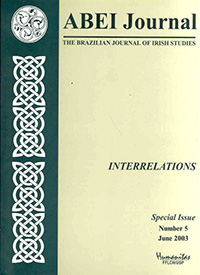Interrelations: Blake and Yeats
DOI:
https://doi.org/10.37389/abei.v5i1.182253Keywords:
Blake, Yeats, Interrelations, Symbols, Irish LiteratureAbstract
Both Blake and Yeats were prophets of their own time and annunciators of the future. Both used a rich mythological structure of symbols to communicate the universality and unity of their ideas. The Illuminated Books present a prophetic view, one which projects the future. Yeats’ search into the Spiritus Mundi, the origin of all images, may be seen in terms of Blake’s archetypal forms. Dance, symbolizing destructive human passions which prohibit the individual’s entry into the luminous circle of perfection, can be found employed analogously in the work of both poets. Whereas Blake had always decried the sadistic Female Will or Sphinx, Yeats is influenced by the Nietzschean acceptance of joy in pain and this is the triumph of A Full Moon in March. In Yeats the dance signifies the height of passionate abandonment. Yeats’ apocalyptic dancers or goddesses are basically Blake’s archetypal roles of the Female. The Female in Blake represents paradoxically the elements of both complete unity and conflict in the male. Both Blake and Yeats see the feminine principle as controlling human destiny. These archetypal images are related through their role of prophecy. Both Blake and Yeats denigrate reason, law, science and materialism. However, while Blake deplores the possessive Female Will in its obstruction of the imagination through the force of materialism, the binding to nature, bringing destruction to humanity, Yeats’ heroes are created from suffering and destruction. While Blake urges the fulfilment of the imaginative or eternal life through the liberated life of the senses and denounces the exclusively material world as frigid and dark, Yeats, in his final vision, urges the fulfilment of sensual experience, acclaiming heroic suffering through tragedy as creative joy, which transcends the world of time.
References
Adams, Hazard. (1955) Blake and Yeats: The Contrary Vision. New York: Russell & Russell, 1968.
Billigheimer, Rachel V. Wheels of Eternity: A Comparative Study of William Blake and William
Butler Yeats. Dublin/New York: Gill and Macmillan/St. Martin’s P., 1990.
Billigheimer, Rachel V. “The Female in Blake and Yeats”, in The College English Association Critic, v. 48/49, n. 4/1, 1986, 137-44.
Billigheimer, Rachel V. “Tragedy and Transcedence in the Dance Plays of W. B. Yeats”, in The Canadian Journal of Irish Studies 25th Anniversary Double Issue, v. 25, n. 1-2, 1999, 247-63.
Billigheimer, Rachel V. “The Rose of Ireland in the Early Poems of W. B. Yeats”, in Studies: An Irish Quarterly Review, v. 91, n. 363, 2002, 276-83.
Bloom, Harold. Yeats. New York: Oxford UP, 1970.
Bradford, Curtis B. Yeats at Work: Carbondale and Edwardsville: Southern Illionois UP, 1965.
Damrosch, Leopold, Jr. Symbol and Truth in Blake’s Myth Princeton: Princeton UP, 1980.
Dickstein, Morris. “The Price of Experience: Blake’s Reading of Freud”, in Smith, Joseph H.; M. D.
(Ed.). Psychiatry and the Humanities, v. 4. The Literary Freud: Mechanisms of Defense and the Poetic Will. New Haven and London: Yale UP, 1980, 67-111.
Donoghue, Denis. “Yeats: The Question of Symbolism”, in Ronsley Joseph, (Ed.). Myth and Reality in Irish Literature. Waterloo, Ontario: Wilfred Laurier UP. 1977, 99-115.
Ellis, Edwin John and Yeats William Butler (Eds.). The Works of William Blake: Poetic Symbolic and Critical, v. 3. London: Quaritch, 1893.
Erdman, David, V.; Bloom, Harold (Eds.). (1965) The Complete Poetry and Prose of William Blake
New York: Doubleday, Newly Revised Edition, 1982.
Fowlie, Wallace.(1953) Mallarmé. Chicago/London: U of Chicago P., 1970.
George, Diana Hume. Blake and Freud. Ithaca and London: Cornell UP, 1980.
Mandel, Eli. “From Plato’s Cave to Byzantium”, in Criticism: the Silent-Speaking Words. Toronto: CBC Publications, 1966, 10-8.
Parkin, Andrew. “Yeats’s Orphic Voice”, in The Canadian Journal of Irish Studies, v. 2, n. 1, 1976, 44-50.
Ronsley, Joseph (Ed.). Myth and Reality in Irish Literature. Waterloo/Ontario: Wilfred Laurier UP, 1977.
Whitaker, Thomas R. Swan and Shadow: Yeats’s Dialogue with History. Chapel Hill: The U. of North Carolina P. 1964.
Yeats, William Butler. (1934) The Collected Plays of W. B. Yeats. London: Macmillan, 1977.
_____. (1933) The Collected Poems of W. B. Yeats. London: Macmillan, 1969.
_____. The Letters of W. B. Yeats. London: Rupert Hart-Davis, 1954.
_____. Mythologies. New York: Collier, 1974.
_____. Explorations. London: Macmillan, 1962.
_____. (1955) Autobiographies. London: Macmillan, 1973.
_____. (1937) A Vision. New York: Collier, 1972.
_____. (Unpublished dialogue, 1916) “The Poet and the Actress”, in Bradford. Curtis Yeats at Work
Carbondale and Edwardsville: Southern Illinois UP, 1965.
_____. (1961) Essays and Introductions. New York: Collier, reprinted 1973.
Downloads
Published
Issue
Section
License
Copyright (c) 2003 Rachel V. Billigheimer

This work is licensed under a Creative Commons Attribution-NonCommercial 4.0 International License.


